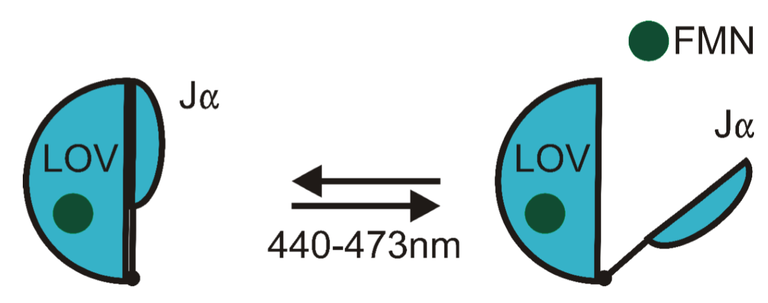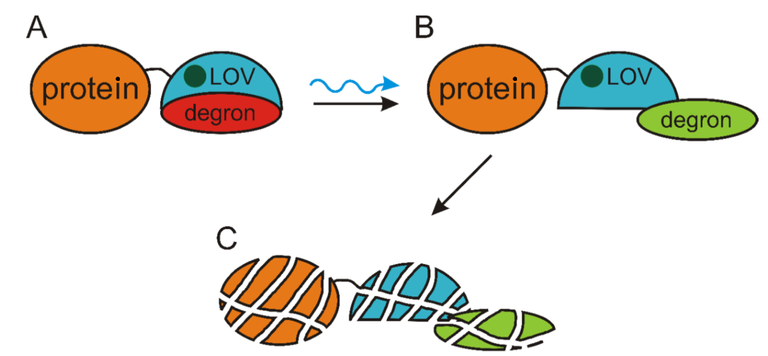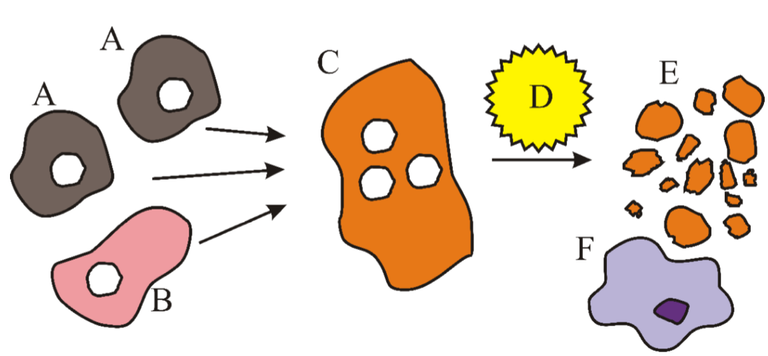Hi guys! I am back with another article about optogenetics. Today I will cover a bit non-standard application of this technique – a way to destroy cancer cells with light!

Optogenetics 101
I have dedicated quite some time into creating a series about optogenetics, so if you want to know more, look at the links at the bottom of the article. But basically, optogenetics employ light sensitive proteins to change the activity of cells. Normally it is used in neurobiology to artificially activate or inactivate neurons, but there are other applications as well. Last time (HERE) I talked about a bit different type of optogenetics that used proteins that change their conformation and thus can propagate or inhibit activity of certain genes. In this article I will show you different light sensitive protein that can be used to destroy cancer cells.
Introducing LOV
Light-oxygen-voltage-sensing (LOV) domain is a light sensitive part of phototropin (photoreceptor protein that can be used by variety of organisms to sense blue light). LOV is composed from two parts – mononucleotide-binding centre and Jα-helical extension of the carboxyl end (You do not have to remember that). The chromophore of this whole system is flavin mononucleotide (FMN). What is chromophore? It is a light sensing domain of certain protein, that somehow reacts to the presence of light (most usually with conformational change). Light stimulation of FMN with blue light (440-473 nm) starts a cascade of structural changes in the centre of LOV and these changes then propagate the conformational change of LOV which results in dissociation and extension of Jα-helix. Basically, you shine blue light onto this LOV domain and it extends it Jα-helix. When you stop the light stimulation, the whole system returns to its standard conformation. You can see this process bellow.

Application
What is this good for? Well, you can for example bind something to the Jα-helix, like some protein. This protein will be allosterically inhibited (non-functional due to the conformation LOV domain), but when the extension of Jα-helix occurs the bound protein will no longer be inhibited and will regain its functionality. But let’s get a little bit more specific.
Renicke et al. in 2013 used LOV domain, more specifically LOV2 domain of phototropin 1 from plant Arabidopsis thaliana. They fused Jα-helix of LOV2 with synthetic degron (degradation initiating sequence – meaning that when such sequence is in the cell it will be very quickly destroyed). Without light nothing happened and the degron was inactivated. Stimulation with blue light however, resulted in conformational changes in LOV domain and activation of degron – this induced the degradation of the whole complex or even other proteins bound to this complex (see the scheme below).

A - Degron is inactive
B - Light promotes the activation of degron
C - Degradation of the protein complex
What about cancer
Cells have more ways to go (die). One possible way is apoptosis. Apoptosis also known as programmed cell death is an essential mechanism for the evolution of multicellular organism or immune reaction. It is somewhat of cellular suicide – the cell activates several mechanisms that result in healthy death of the cell – meaning that it is not like necrosis and it is not harmful for surrounding cells. Apoptosis is usually the approach that cells use when they malfunction – this protects the integrity of the whole organism. Unfortunately, sometimes is the mechanism of programmed cell death disrupted and the malfunctioning cells continue to divide and are harmful to the organism (cancer).
Apoptosis is regulated by a group of proteases termed caspases. Mills et al. (2012) created a fusion construct named L57R composed from LOV and caspase 7. Activation of caspase 7 is one of the last steps of initiation of apoptosis and the presence of its active form in cell induces cell death. Fusion of caspase 7 with LOV resulted in allosteric inhibition of the activity of caspase 7. However, stimulation with blue light resulted in activation of caspase 7 and thus induction of apoptosis. Nagaraj et al (2013) took the approach to new level. They created programmed cells expressing L57R that were able to find cancer cells and form syncytium with them (fusion of more cells together). Subsequent stimulation with blue light resulted in the apoptosis and thus degradation of the whole syncytium (along with cancer cells). Schematic model of this approach can be seen bellow.

A - Tumor cells
B - Programmed cells
C - Syncytium
D - Light stimulation causes apoptosis
E - Cell debris
F - Macrophages clean the mess :)
Concluding remarks
Well, even though this technology looks very promising, it is still long way from clinical application. I think it is interesting to see the application of approaches that were initially meant to control the activity of neurons being used for something remotely different. And this is only one example. Optogenetics are being used as a research tool for cardio-vascular diseases, restoration or sight or regeneration of damaged neurons – all fascinating fields! Maybe next time I will cover one of these topics.
Thank you for your time and have a great day!
Previous parts of Optogenetics series:
Part 1 – Introduction
Part 2 – History of Optogenetics
Part 3 – Opsins – light sensitive proteins
Part 4 – Gene expression and delivery in Optogenetics
Part 5 – Light stimulation and delivery in Optogenetics
Part 6 – Readout of results in Optogenetics
Part 7 – My own research experience of using Optogenetics
Part 8 – Activate genes with light
Refernces:
Harper et al. (2003) - Structural Basis of a Phototropin Light Switch
Mills et al. (2012) - Engineering a Photoactivated Caspase-7 for Rapid Induction of Apoptosis
Nagaraj et al. (2013) – Programming Membrane Fusion and Subsequent Apoptosis into Mammalian Cells
Renicke et al. (2013) - A LOV2 Domain-Based Optogenetic Tool to Control Protein Degradation and Cellular Function
Other references are directly in the text
Being A SteemStem Member
My dad has cancer. I appreciate this won't work for all types but I'll send the link for this to him to read. Thank you
Sorry to hear that...
Well, sadly this kind of technology is extremly long ways from being available to patients. However, cancer research is rapidly advancing and with each month there are new discoveries.
I wish you and your dad all the best!
Although I understand principles of physical chemistry, for me it's still fascinating how photons can reshape molecules. It's simply beautiful.
It is weird, but yeah,fascinating. And for me kind of hard to imagine, haha.
Next time I will probably introduce a way to restore sight in blind patients using optogenetic tools - that is something that is already being tested on human tissue.